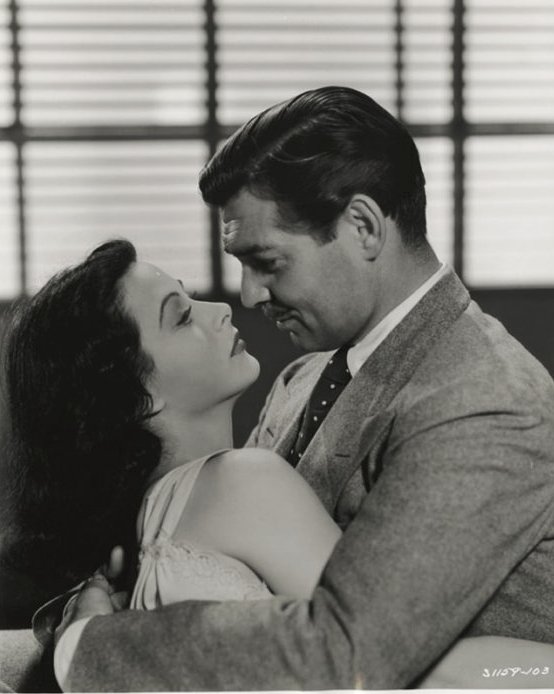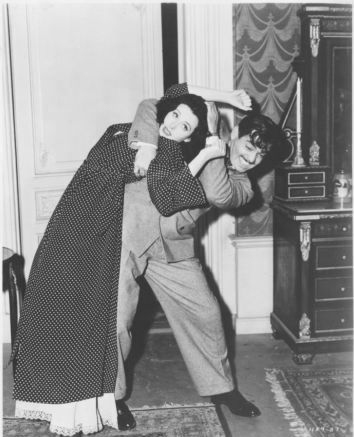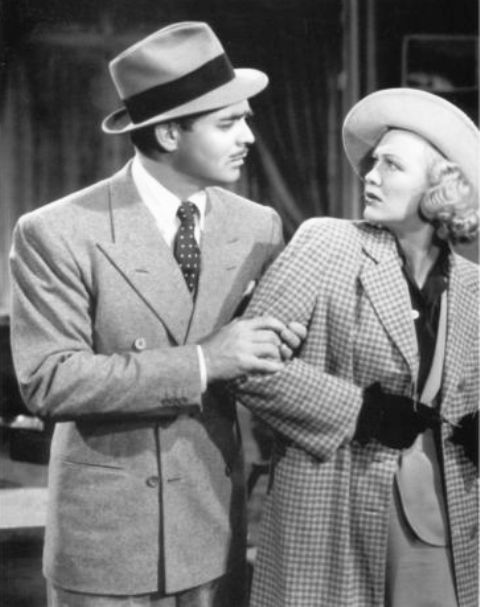Comrade X (1940)

Release Date: December 13, 1940
Directed by: King Vidor
Studio: MGM
Costarring:
Hedy Lamarr
Felix Bressart
Oskar Homolka
Eve Arden
Available on DVD from The Warner Brothers Archive Collection
DearMrGable.com’s Movie of the Month, October 2013
Gable is McKinley Thompson, an American reporter living in Russia who is secretly sending news out of the country as the elusive “Comrade X”. His bumbling valet, Igor (Bressart) discovers who he is and blackmails him to take his headstrong Communist daughter (Lamarr) out of Russia to protect her from prosecution. Everything doesn’t go as planned and soon the three of them are racing out of Russia with the Russian army on their tails.
Reviews
Motion Picture magazine, March 1941:
X here doesn’t stand for an unknown quantity you may be sure for Metro-Goldwyn-Mayer, the producers of Comrade X, have a definite hit on their hands which will result in large quantities of profits for them and large quantities of laughs for you. However, the title does lend a clue, for who doesn’t know—especially after Ninotchka—that the only existing relationship in present-day Russia is that of comradeship. But don’t for a minute think that Sex is missing in the Soviet for while a boy and a girl may be comrades there’s no law against them being bedfellows, too. And speaking of SEX who can handle that situation better than Metros’ two exponents of sex appeal–Clark Gable and Hedy Lamarr? In this satire of the Soviet–screenplay by Ben Hecht and Charles Lederer–Hedy plays a streetcar conductor and Gable and American newspaperman. The two get together when Hedy’s papa–Felix Bressart–threatens to expose Gable as Comrade X unless he helps his daughter escape. It may be blackmail but what could a fellow do–particularly Gable–but consent? Clark and Hedy are swell and they get grand support.
Photoplay magazine, March 1941:
Right down the broad highway to slapstick comedy marches this hilarious farce on events in modern Russia, with two of our most intriguing stars, Gable and Lamarr, in the driver’s seat.
Beginning as a satire with Gable a newspaper man smuggling out uncensored news to America, the film grows more incredible by the minute. Especially when the story has Gable forced to flee Russia in company with his “shotgun” bride, Hedy Lamarr—a streetcar conductor, believe it or not. A chase to end all chases, with Hedy and Gable in one tank against an army of tanks. This sequence is a downright panic.
While this story lacks all the finesse and subtlety of “Ninotchka” it nevertheless is riotous fun. But for Gable and Lamarr, we wonder.
Your Reviewer Says: Out of its mind.
Photoplay magazine, May 1941:
Take Gable as a newspaper reporter smuggling uncensored news out of Russia, add Hedy Lamarr as a streetcar conductor with whom he’s forced to leave Russia, mix up with a chase consisting of Lamarr and Gable in one tank against an army of tanks and you have riotous slapstick entertainment.
Screen Life magazine, July 1941:
Lighthearted satire on Communists with Hedy Lamarr as the serious-minded Red, Clark Gable as the American newspaper reporter operating under the title role. Dialogue is good and there is a honey of a slapstick sequence in which the stars are chased by an army of tanks. ***
Liberty magazine, January 25, 1941:
***1/2 Here’s a lively, raucous farce about Russia, with Clark Gable as a rowdy American newspaperman and Hedy Lamarr as a Soviet motorman!! Things happen right from the start–and keep happening. The Kremlin is boiling over stories published in United States papers about Russian famines, assassinations, and threatened revolts, sent out in some mysterious fashion by an unknown correspondent who signs himself Comrade X. So the Ogpu sets its machinery to find the culprit.
Need I say that the lazy tippler, played by Gable, turns out to be the daring Comrade X? He has to use all his wits to get himself out of a dungeon. Not only does he have to save himself but also the decorative motorman. The whole things runs into one of those chases–but it’s a bigger and better chase. Clark and Hedy steal a general’s huge armored tank, all the division tanks follow, first dutifully, then with guns barking.
The film is fast and funny. It is notable from at least one angle: It is the first time that Hollywood has gone ahead with utter disregard for what some foreign government will think. Another point of public interest: Hedy in a Soviet nightgown!

Quote-able Gable
“What? Oh, we’re here, huh?” first line
“Face the facts, baby, there ain’t no news in Russia.”‘
“I’ve never seen a Russian yet who wasn’t suspicious. Pathetic.”
“Everybody’s a spy. That’s why I like you, you’re too dumb to be a spy.”
“You bumblehead maniac!”
“So the deal is I get an obstinate lady motorman out of a country she doesn’t want to leave?”
“Ever hear of the Brooklyn Dodgers? They get murdered every day!”
“There’s nothing you couldn’t sell with a smile like that.”
“I don’t talk to ladies that start yelling. It’s a rule I’ve got.”
“Fine wedding night this turned out to be!”
“If that’s comrade x, I’ll eat the Kremlin without sauce!”
“Hey listen baby, you’re two jumps ahead of a butterfly net–like nearly all the Russians I know. They’ve all blindfolded themselves an they’re hanging from the chandeliers from their toes, throwing rocks at each other. And for a finish they’ll set fire to their pants! They’re all a lot of political palookas, playing at Halloween! When you ask them what they’re doing, they’ll holler back, ‘Ideals!’ Well I’ve got a few ideals of my own, baby. An right now they tell me that you weren’t meant to be a motorman or a pumpkinhead. You’re a beautiful woman and nobody’s going to turn a machine gun on you if I can help it. That’s my politics.”
“I’ve got a confession to make. I lied to you. About the USA. It ain’t a sparse old desert. Hey, it’s pie a la mode. Two pant suits and the home of the brave, Pike’s Peak and Coney Island. And I told you wrong about the Brooklyn Dodgers–they finished in second place!”
“Go for third!” last line
Behind the Scenes
Nominated for an Academy Award– Best Writing, Original Story.
Gable liked to wear trench coats in movies, considering them lucky. Burberry made him one especially for this film and it instantly became his favorite; he kept it and wore it for twenty years. At an MGM auction in 1969, a representative from Burberry tried to bid and win the coat, but it was sold to an anonymous bidder for $1,250.
